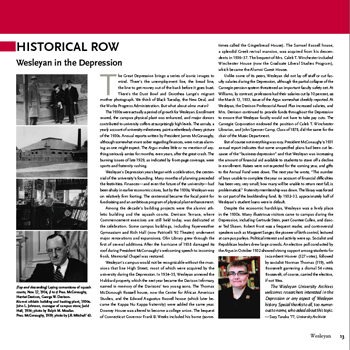HISTORICAL ROW: WESLEYAN IN THE DEPRESSION
 The Great Depression brings a series of iconic images to mind. There’s the unemployment line, the bread line, the line to get money out of the bank before it goes bust. There’s the Dust Bowl and Dorothea Lange’s migrant mother photograph. We think of Black Tuesday, the New Deal, and the Works Progress Administration. But what about alma mater?
The Great Depression brings a series of iconic images to mind. There’s the unemployment line, the bread line, the line to get money out of the bank before it goes bust. There’s the Dust Bowl and Dorothea Lange’s migrant mother photograph. We think of Black Tuesday, the New Deal, and the Works Progress Administration. But what about alma mater?
The 1930s were actually a period of growth for Wesleyan. Enrollment soared, the campus physical plant was enhanced, and major donors contributed to university coffers at surprisingly high levels. The annals, a yearly account of university milestones, paint a relentlessly cheery picture of the 1930s. Annual reports written by President James McConaughy, although somewhat more sober regarding finances, were not as alarming as one might expect. The Argus makes little or no mention of anything seriously amiss for months, even years, after the great crash. The burning issues of late 1929, as indicated by front-page coverage, were sports and fraternity rushing.
Wesleyan’s Depression years began with a celebration, the centennial of the university’s founding. Many months of planning preceded the festivities. Finances—and even the future of the university—had been shaky in earlier economic crises, but by the 1930s, Wesleyan was on relatively firm footing. The centennial became the focal point for fundraising and an ambitious program of physical plant enhancement.
Among the decade’s building projects were the alumni athletic building and the squash courts. Denison Terrace, where Commencement exercises are still held today, was dedicated at the celebration. Some campus buildings, including Fayerweather Gymnasium and Rich Hall (now Patricelli ’92 Theater) underwent major renovations and expansions. Olin Library grew through the first of several additions. After the hurricane of 1938 damaged its roof during President McConaughy’s welcoming speech to incoming frosh, Memorial Chapel was restored.
Wesleyan’s campus would not be recognizable without the mansions that line High Street, most of which were acquired by the university during the Depression. In 1934–35, Wesleyan annexed the Hubbard property, which the next year became the Davison Infirmary, named in memory of the Davisons’ two young sons. The Thomas McDonough Russell house, now the Center for African American Studies, and the Edward Augustus Russell house (which later became the Kappa Nu Kappa fraternity) were added the same year. Downey House was altered to become a college union. The bequest of Connecticut Governor Frank B. Weeks included his home (sometimes called the Gingerbread House). The Samuel Russell house, a splendid Greek revival mansion, was acquired from his descendents in 1936–37. The bequest of Mrs. Caleb T. Winchester included Winchester House (now the Graduate Liberal Studies Program), which became the Alumni Guest House.
Unlike some of its peers, Wesleyan did not lay off staff or cut faculty salaries during the Depression, although the partial collapse of the Carnegie pension system threatened an important faculty safety net. At Williams, by contrast, professors had their salaries cut by 10 percent, as the March 13, 1933, issue of the Argus somewhat cheekily reported. At Wesleyan, the Denison Professorial Award Plan increased salaries, and Mrs. Denison continued to provide funds throughout the Depression to ensure that Wesleyan faculty would not have to take pay cuts. The Carnegie Corporation endowed the position of Caleb T. Winchester Librarian, and John Spencer Camp, Class of 1878, did the same for the chair of the Music Department.
But of course not everything was rosy. President McConaughy’s 1931 annual report indicates that some unspecified plans had been cut because of the “business depression” and that Wesleyan was increasing the amount of financial aid available to students to stave off a decline in enrollment. Raises were not expected for the coming year, and gifts to the Annual Fund were down. The next year he wrote, “The number of boys unable to complete the year on account of financial difficulties has been very, very small; how many will be unable to return next fall, is problematical.” Fraternity membership was down. The library was forced to cut part of the bookbinding fund. By 1932–33, approximately half of Wesleyan’s student loans were in default.
Despite the economic hardships, Wesleyan was a lively place in the 1930s. Many illustrious visitors came to campus during the Depression, including Gertrude Stein, poet Countee Cullen, and dancer Ted Shawn. Robert Frost was a frequent reader, and controversial speakers such as Margaret Sanger, the pioneer of birth control, lectured at campus parleys. Political interest and activity were up. Socialist and Republican leaders drew large crowds. An election poll conducted by the Argus in October 1932 showed strong support among students for incumbent Hoover (327 votes), followed by socialist Norman Thomas (119), with Roosevelt garnering a dismal 54 votes. Roosevelt, of course, carried the election, if not Wes.
The Wesleyan University Archives welcomes researchers interested in the Depression or any aspect of Wesleyan history. Special thanks to all, too numerous to name, who asked about this topic.
—Suzy Taraba ’77, University Archivist
